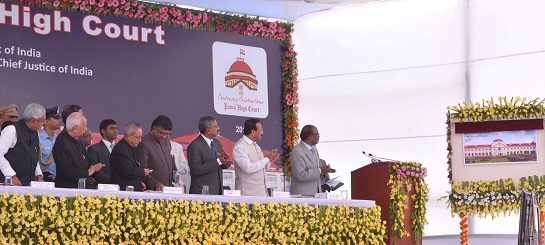
The President of India, Pranab Mukherjee inaugurated the Centenary Year Celebrations of Patna High Court on 18th April 2015 at Patna. He released a commemorative postage stamp on this occasion.

Speaking on the occasion, the President said that when the foundation-stone of the Patna High Court building was laid on December 01, 1913, the then Viceroy and Governor-General of India, Lord Hardinge had said: “I feel assured, that within its walls in future days, justice will be administered with courage and impartiality, to the terror of evil-doers, and to the triumph of every cause which is right and true, so that the High Court of Bihar shall earn a name for sound sense and good law.The President said that the many legal luminaries of the Patna High Court included the first President of India and one of the chief architects of our nation, Dr. Rajendra Prasad who was a practitioner before this Court. Shri Syed Hasan Imam who presided over the Indian National Congress in 1918 was also a member of the Patna High Court Bar. The first President of the Constituent Assembly, Dr. Sachchidanand Sinha was a member of the Bar of this Court. Three Chief Justices from Patna High Court namely, Justice B.P. Sinha, Justice Lalit Mohan Sharma and Justice R.M. Lodha went on to become the Chief Justice of India. .The foundation-stone of the High Court Building was laid on, the 1st December, 1913 by His Excellency the late Viceroy and Governor-General of India, Lord Hardinge of Penshurst.Proclamation made by the Governor-General of India on the 22nd March, 1912 the territories of Bihar and Orissa which were formerly subject to and included within the limits of the Presidency of Fort William in Bengal, were promoted to the status of a separate province, and by Letters Patent, dated the 9th February, 1916 the Patna High Court was ushered into existence with Circuit sittings at Cuttack, and form the 26th February, 1916, the date on which the aforesaid Letters Patent was published in the Gazette of India, the High Court of Judicature at Fort William in Bengal ceased to exercise jurisdiction, Civil, Criminal, Admiralty, Matrimonial, Testamentary and Intestate, Enrolment, etc. in all matters in which jurisdiction was given to the High Court of Judicature at Patna. Thus the ancient city of Pataliputra had a High Court of its own in 1916 with Sir Edward Maynard Des Champs Chamier, Kt. Barrister-at-Law as its first Chief Justice and Sarvashri Saiyid Sharfuddin, Barrister-at-Law, Edmund Pelly Chapman, I.C.S., Basant Kumar Mullick, I.C.S., Francis, Reginald Roe, I.C.S, Cecil Atkinson, barrister-at-Law and Jwala Prasad, B.A., LL.B., as Puisne Judges.
The Patna High Court started its work in 1916 with the Chief Justice and six puisne Judges. In the year 1947, the sanctioned strength of the Court was nine permanent and three additional Judges. Though a separate province for Orissa was created in the year 1937, this High Court exercised jurisdiction over the territories of that province till 26th July, 1948, when a separate High Court was constituted for Orissa. Even after the constitution of the Orissa High Court, the sanctioned strength of Judges for this Court remained the same. In February, 1950, the three posts of Additional Judges were made permanent. The post of the 13th permanent Judge was sanctioned in September, 1952, and that of the 14th permanent Judge in January, 1956. Since then there has been no increase in the sanctioned strength of the permanent Judges of the Court. Four posts of Additional Judges have also been sanctioned from time to time since July, 1957. In November, 1965 there were 14 permanent Judges, including the Chief Justice and three Additional Judges. At present there are 29 permanent Judges including the Chief Justice and 14 Additional Judges.
